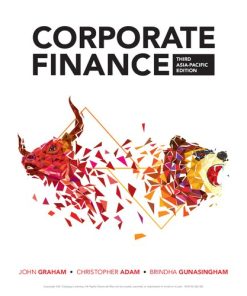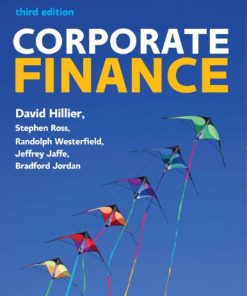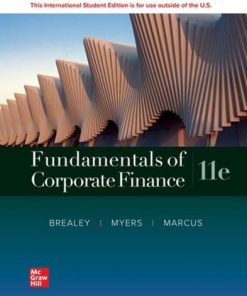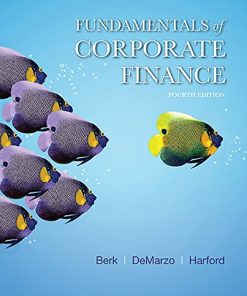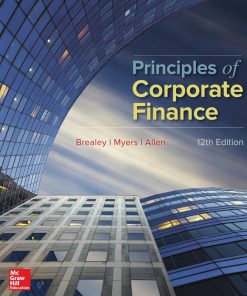(Ebook PDF) CFIN 6 Corporate Finance 6th Edition by Scott Besley, Eugene Brigham ISBN 9798214339443 1337407356 full chapters
$50.00 Original price was: $50.00.$25.00Current price is: $25.00.
CFIN 6: Corporate Finance 6th Edition Scott Besley Digital Instant Download
Author(s): Scott Besley, Eugene Brigham
ISBN(s): 9781337407342, 9781337407359, 1337407348, 1337407356
Edition: 6
File Details: PDF, 28.31 MB
Year: 2018
Language: English
SKU: EB-10548944
Category: Business & Economics - Professional Finance
Tags: Eugene Brigham, Scott Besley
(Ebook PDF) CFIN 6 Corporate Finance 6th Edition by Scott Besley, Eugene Brigham-Ebook PDF Instant Download/Delivery:9798214339443,1337407356
Instant download Full Chapter of CFIN 6 Corporate Finance 6th Edition after payment

Product details:
ISBN 10:1337407356
ISBN 13:9798214339443
Author: Scott Besley, Eugene Brigham
Using your ideal combination of printed text and online resources, learn Corporate Finance YOUR Way with CFIN6! This easy-reference, paperback textbook presents course content through visually engaging chapters as well as Chapter Review Cards that consolidate the best review material into a ready-made study tool. Add in access to assignments and documents from your instructor, and you have everything you need in one place that’s always accessible!
Table of Contents:
- Part 1. Introduction to Managerial Finance
- 1. An Overview of Managerial Finance
- 1-1. What Is Finance?
- 1-1a. General Areas of Finance
- 1-1b. The Importance of Finance in Non-Finance Areas
- 1-2. Alternative Forms of Business Organization
- 1-2a. Proprietorship
- 1-2b. Partnership
- 1-2c. Corporation
- 1-2d. Hybrid Forms of Business: LLP, LLC, and S Corporation
- 1-2e. Which Form of Business Is Best?
- 1-3. What Goal(s) Should Businesses Pursue?
- 1-3a. Managerial Actions to Maximize Shareholder Wealth
- 1-3b. Should Earnings per Share (EPS) Be Maximized?
- 1-3c. Managers’ Roles as Agents of Stockholders
- 1-4. What Roles Do Ethics and Governance Play in Business Success?
- 1-4a. Business Ethics
- 1-4b. Corporate Governance
- 1-5. Forms of Businesses in Other Countries
- 1-5a. Multinational Corporations
- 1-5b. Multinational Versus Domestic Managerial Finance
- 1-LO. Learning Outcomes
- 1-KMFC. Key Managerial Finance Concepts
- 1-KT. Key Terms
- 1-PR. Problems
- Part 2. Essential Concepts in Managerial Finance
- 2. Analysis of Financial Statements
- 2-1. Financial Reports
- 2-2. Financial Statements
- 2-2a. The Balance Sheet
- 2-2b. The Income Statement
- 2-2c. Statement of Cash Flows
- 2-2d. Statement of Retained Earnings
- 2-3. Financial Statement (Ratio) Analysis
- 2-3a. Liquidity Ratios
- 2-3b. Asset Management Ratios
- 2-3c. Debt Management Ratios
- 2-3d. Profitability Ratios
- 2-3e. Market Value Ratios
- 2-3f. Comparative Ratios (Benchmarking) and Trend Analysis
- 2-3g. Summary of Ratio Analysis: The DuPont Analysis
- 2-4. Uses and Limitations of Ratio Analysis
- 2-4a. Accounting in an International Setting
- 2-LO. Learning Outcomes
- 2-KFSAC. Key Financial Statement Analysis Concepts
- 2-KT. Key Terms
- 2-EC. Equation Card
- 2-PR. Problems
- 3. The Financial Environment: Markets, Institutions, and Investment Banking
- 3-1. What Are Financial Markets?
- 3-1a. Importance of Financial Markets
- 3-1b. Flow of Funds
- 3-1c. Market Efficiency
- 3-2. Types of Financial Markets
- 3-2a. Stock Markets
- 3-2b. Types of General Stock Market Activities
- 3-2c. Physical Stock Exchanges
- 3-2d. The Over-the-Counter (OTC) Market and NASDAQ
- 3-2e. Electronic Communications Networks (ECN)
- 3-2f. Competition among Stock Markets
- 3-2g. Regulation of Securities Markets
- 3-3. The Investment Banking Process
- 3-3a. Raising Capital: Stage I Decisions
- 3-3b. Raising Capital: Stage II Decisions
- 3-3c. Raising Capital: Selling Procedures
- 3-4. Financial Intermediaries and Their Roles in Financial Markets
- 3-4a. Types of Financial Intermediaries
- 3-5. International Financial Markets
- 3-5a. Financial Organizations in Other Parts of the World
- 3-5b. Recent Legislation of Financial Markets
- 3-LO. Learning Outcomes
- 3-KFEC. Key Financial Environment Concepts
- 3-KT. Key Terms
- 3-EC. Equation Card
- 3-PR. Problems
- 4. Time Value of Money
- 4-1. Cash Flow Patterns
- 4-2. Future Value (FV)
- 4-2a. FV of a Lump-Sum Amount— FV n
- 4-2b. FV of an Ordinary Annuity— FVA n
- 4-2c. FV of an Annuity Due— FVA ( DUE ) n
- 4-2d. FV of an Uneven Cash Flow Stream— FVCF n
- 4-3. Present Value (PV)
- 4-3a. PV of a Lump-Sum Amount—PV
- 4-3b. PV of an Ordinary Annuity— PVA n
- 4-3c. PV of an Annuity Due— PVA ( DUE ) n
- 4-3d. Perpetuities
- 4-3e. PV of an Uneven Cash flow Stream— PVCF n
- 4-3f. Comparison of FV with PV—Understanding the Numbers
- 4-4. Solving for Interest Rates (r) or Time (n)
- 4-4a. Solving for r
- 4-4b. Solving for n
- 4-5. Annual Percentage Rate (APR) and Effective Annual Rate (EAR)
- 4-5a. Semiannual and Other Compounding Periods
- 4-5b. Comparison of Different Interest Rates
- 4-6. Amortized Loans
- 4-LO. Learning Outcomes
- 4-KTVMC. Key TVM Concepts
- 4-KT. Key Terms
- 4-EC. Equation Card
- 4-PR. Problems
- Part 3. Valuation—Financial Assets
- 5. The Cost of Money (Interest Rates)
- 5-1. The Cost of Money
- 5-1a. Realized Returns (Yields)
- 5-1b. Factors That Affect the Cost of Money
- 5-1c. Interest Rate Levels
- 5-2. Determinants of Market Interest Rates
- 5-2a. The Nominal, or Quoted, Risk-Free Rate of Interest, r RF
- 5-2b. Inflation Premium (IP)
- 5-2c. Default Risk Premium (DRP)
- 5-2d. Liquidity Premium (LP)
- 5-2e. Maturity Risk Premium (MRP)
- 5-3. The Term Structure of Interest Rates
- 5-3a. Why Do Yield Curves Differ?
- 5-3b. Does the Yield Curve Indicate Future Interest Rates?
- 5-4. Other Factors That Influence Interest Rate Levels
- 5-4a. Federal Reserve Policy
- 5-4b. Federal Deficits
- 5-4c. International Business (Foreign Trade Balance)
- 5-4d. Business Activity
- 5-5. Interest Rate Levels and Stock Prices
- 5-5a. The Cost of Money as a Determinant of Value
- 5-LO. Learning Outcomes
- 5-KCMC. Key Cost of Money (Interest Rate) Concepts
- 5-KT. Key Terms
- 5-EC. Equation Card
- 5-PR. Problems
- 6. Bonds (Debt)—Characteristics and Valuation
- 6-1. Characteristics and Types of Debt
- 6-1a. Debt Characteristics
- 6-1b. Types of Debt
- 6-1c. Short-Term Debt
- 6-1d. Long-Term Debt
- 6-1e. Bond Contract Features
- 6-1f. Foreign Debt Instruments
- 6-2. Bond Ratings
- 6-2a. Bond Rating Criteria
- 6-2b. Importance of Bond Ratings
- 6-2c. Changes in Ratings
- 6-3. Valuation of Bonds
- 6-3a. The Basic Bond Valuation Model
- 6-3b. Bond Values with Semiannual Compounding
- 6-4. Finding Bond Yields (Market Rates): Yield to Maturity and Yield to Call
- 6-4a. Yield to Maturity (YTM)
- 6-4b. Yield to Call (YTC)
- 6-5. Interest Rates and Bond Values
- 6-5a. Changes in Bond Values over Time
- 6-5b. Interest Rate Risk on a Bond
- 6-5c. Bond Prices in Recent Years
- 6-LO. Learning Outcomes
- 6-KBVC. Key Bonds Valuation Concepts
- 6-KT. Key Terms
- 6-EC. Equation Card
- 6-PR. Problems
- 7. Stocks (Equity)—Characteristics and Valuation
- 7-1. Types of Equity
- 7-1a. Preferred Stock
- 7-1b. Common Stock
- 7-1c. Equity Instruments in International Markets
- 7-2. Stock Valuation—The Dividend Discount Model (DDM)
- 7-2a. Expected Dividends as the Basis for Stock Values
- 7-2b. Valuing Stocks with Constant, or Normal, Growth (g)
- 7-2c. Valuing Stocks with Nonconstant Growth
- 7-3. Other Stock Valuation Methods
- 7-3a. Valuation Using P/E Ratios
- 7-3b. Evaluating Stocks Using the Economic Value Added Approach
- 7-4. Changes in Stock Prices
- 7-LO. Learning Outcomes
- 7-KSVC. Key Stocks Valuation Concepts
- 7-KT. Key Terms
- 7-EC. Equation Card
- 7-PR. Problems
- 8. Risk and Rates of Return
- 8-1. Defining and Measuring Risk
- 8-1a. Probability Distributions
- 8-2. Expected Rate of Return
- 8-2a. Measuring Total (Stand-Alone) Risk: The Standard Deviation ( σ )
- 8-2b. Coefficient of Variation (Risk/Return Ratio)
- 8-2c. Risk Aversion and Required Returns
- 8-3. Portfolio Risk—Holding Combinations of Investments
- Section Content
- 8-3a. Firm-Specific Risk Versus Market Risk
- 8-3b. The Concept of Beta
- 8-3c. Portfolio Beta Coefficients
- 8-4. The Relationship between Risk and Rates of Return: The CAPM
- 8-4a. The Impact of Inflation
- 8-4b. Changes in Risk Aversion
- 8-4c. Changes in a Stock’s Beta Coefficient
- 8-4d. A Word of Caution
- 8-5. Stock Market Equilibrium
- 8-6. Different Types of Risk
- 8-LO. Learning Outcomes
- 8-KRC. Key Risk Concepts
- 8-KT. Key Terms
- 8-EC. Equation Card
- 8-PR. Problems
- Part 4. Valuation—Real Assets (Capital Budgeting)
- 9. Capital Budgeting Techniques
- 9-1. Importance of Capital Budgeting
- 9-1a. Generating Ideas for Capital Projects
- 9-1b. Project Classifications
- 9-1c. The Post-Audit
- 9-2. Evaluating Capital Budgeting Projects
- 9-2a. Net Present Value (NPV)
- 9-2b. Internal Rate of Return (IRR)
- 9-3. Comparison of the NPV and IRR Methods
- 9-3a. NPVs and Required Rates of Return—NPV Profiles
- 9-3b. Independent Projects
- 9-3c. Mutually Exclusive Projects
- 9-3d. Cash Flow Patterns and Multiple IRRs
- 9-4. Modified Internal Rate of Return
- 9-5. Use of Capital Budgeting Techniques in Practice
- 9-5a. Payback Period: Traditional (Nondiscounted) and Discounted
- 9-5b. Conclusions on the Capital Budgeting Decision Methods
- 9-5c. Capital Budgeting Methods Used in Practice
- 9-LO. Learning Outcomes
- 9-KCBC. Key Capital Budgeting Concepts
- 9-KT. Key Terms
- 9-EC. Equation Card
- 9-PR. Problems
- 10. Project Cash Flows and Risk
- 10-1. Cash Flow Estimation
- 10-1a. Relevant Cash Flows
- 10-1b. Incremental (Marginal) Cash Flows
- 10-1c. Identifying Incremental Cash Flows
- 10-2. Capital Budgeting Project Evaluation
- 10-2a. Expansion Projects
- 10-2b. Replacement Analysis
- 10-3. Incorporating Risk in Capital Budgeting Analysis
- 10-3a. Stand-Alone Risk
- 10-3b. Corporate (Within-Firm) Risk
- 10-3c. Beta (Market) Risk
- 10-3d. Project Risk Conclusions
- 10-3e. How Project Risk Is Considered in Capital Budgeting Decisions
- 10-4. Multinational Capital Budgeting
- 10-LO. Learning Outcomes
- 10-KCPCFR. Key Concepts about Project Cash Flows and Risk
- 10-KT. Key Terms
- 10-EC. Equation Card
- 10-PR. Problems
- 10-A. Depreciation
- Part 5. Cost of Capital and Capital Structure Concepts
- 11. The Cost of Capital
- 11-1. Component Costs of Capital
- 11-1a. Cost of Debt, r dT
- 11-1b. Cost of Preferred Stock, r ps
- 11-1c. Cost of Retained Earnings (Internal Equity), r s
- 11-1d. Cost of Newly Issued Common Stock (External Equity), r e
- 11-2. Weighted Average Cost of Capital (WACC)
- 11-2a. Determining WACC
- 11-2b. The Marginal Cost of Capital (MCC)
- 11-2c. The MCC Schedule
- 11-2d. Other Breaks in the MCC Schedule
- 11-3. Combining the MCC and Investment Opportunity Schedules (IOS)
- 11-4. WACC versus Required Rate of Return of Investors
- 11-LO. Learning Outcomes
- 11-KCCC. Key Cost of Capital Concepts
- 11-KT. Key Terms
- 11-EC. Equation Card
- 11-PR. Problems
- 12. Capital Structure
- 12-1. The Target Capital Structure
- 12-1a. Business Risk
- 12-1b. Financial Risk
- 12-2. Determining the Optimal Capital Structure
- 12-2a. EPS Analysis of the Effects of Financial Leverage
- 12-2b. EBIT/EPS Examination of Financial Leverage
- 12-2c. The Effect of Capital Structure on Stock Prices and the Cost of Capital
- 12-3. Degree of Leverage
- 12-3a. Degree of Operating Leverage (DOL)
- 12-3b. Degree of Financial Leverage (DFL)
- 12-3c. Degree of Total Leverage (DTL)
- 12-4. Liquidity and Capital Structure
- 12-5. Capital Structure Theory
- 12-5a. Trade-Off Theory
- 12-5b. Signaling Theory
- 12-6. Variations in Capital Structures Among Firms
- 12-6a. Capital Structures around the World
- 12-LO. Learning Outcomes
- 12-KCSC. Key Capital Structure Concepts
- 12-KT. Key Terms
- 12-EC. Equation Card
- 12-PR. Problems
- 13. Distribution of Retained Earnings: Dividends and Stock Repurchases
- 13-1. Dividend Policy and Stock Value
- 13-1a. Information Content, or Signaling
- 13-1b. Clientele Effect
- 13-1c. Free Cash Flow Hypothesis
- 13-2. Dividend Payments in Practice
- 13-2a. Residual Dividend Policy
- 13-2b. Stable, Predictable Dividends
- 13-2c. Constant Payout Ratio
- 13-2d. Low Regular Dividend Plus Extras
- 13-2e. Application of the Different Types of Dividend Payments: An Illustration
- 13-2f. Payment Procedures
- 13-2g. Dividend Reinvestment Plans (DRIPs)
- 13-3. Factors Influencing Dividend Policy
- 13-4. Stock Dividends and Stock Splits
- 13-4a. Stock Splits
- 13-4b. Stock Dividends
- 13-4c. Price Effects of Stock Splits and Stock Dividends
- 13-4d. Balance Sheet Effects of Stock Splits and Stock Dividends
- 13-5. Stock Repurchases
- 13-5a. Advantages and Disadvantages of Stock Repurchases
- 13-6. Dividend Policies Around the World
- 13-LO. Learning Outcomes
- 13-KDREC. Key Distribution of Retained Earnings Concepts
- 13-KT. Key Terms
- 13-EC. Equation Card
- 13-PR. Problems
- Part 6. Working Capital Management
- 14. Managing Short-Term Financing (Liabilities)
- 14-1. Working Capital
- 14-2. The Cash Conversion Cycle
- 14-3. Current Asset (Working Capital) Financing Policies
- 14-4. Sources of Short-Term Financing
- 14-4a. Accruals
- 14-4b. Accounts Payable (Trade Credit)
- 14-4c. Short-Term Bank Loans
- 14-4d. Commercial Paper
- 14-4e. Secured Loans
- 14-5. Computing the Cost of Short-Term Credit
- 14-5a. Computing the Cost of Trade Credit (Accounts Payable)
- 14-5b. Computing the Cost of Bank Loans
- 14-5c. Computing the Cost of Commercial Paper
- 14-5d. Borrowed (Principal) Amount Versus Required (Needed) Amount
- 14-6. Multinational Working Capital Management
- 14-LO. Learning Outcomes
- 14-KCMSTF. Key Concepts for Managing Short-Term Financing (Liabilities)
- 14-KT. Key Terms
- 14-EC. Equation Card
- 14-PR. Problems
- 15. Managing Short-Term Assets
- 15-1. Alternative Current Asset Investment Policies
- 15-2. Cash Management
- 15-2a. The Cash Budget
- 15-2b. Cash Management Techniques
- 15-2c. Acceleration of Receipts
- 15-2d. Disbursement Control
- 15-3. Marketable Securities
- 15-4. Credit Management
- 15-4a. Credit Policy
- 15-4b. Receivables Monitoring
- 15-4c. Analyzing Proposed Changes in Credit Policy
- 15-5. Inventory Management
- 15-5a. Types of Inventory
- 15-5b. Optimal Inventory Level
- 15-5c. Inventory Control Systems
- 15-6. Multinational Working Capital Management
- 15-6a. Cash Management
- 15-6b. Credit Management
- 15-6c. Inventory Management
- 15-LO. Learning Outcomes
- 15-KCMSTA. Key Concepts for Managing Short-Term Assets
- 15-KT. Key Terms
- 15-EC. Equation Card
- 15-PR. Problems
- Part 7. Strategic Planning and Financing Decisions
- 16. Financial Planning and Control
- 16-1. Projected (Pro Forma) Financial Statements
- 16-1a. Step 1: Forecast the Income Statement
- 16-1b. Step 2: Forecast the Balance Sheet
- 16-1c. Step 3: Raising the Additional Funds Needed
- 16-1d. Step 4: Accounting for Financing Feedbacks
- 16-1e. Analysis of the Forecast
- 16-2. Other Considerations in Forecasting
- 16-2a. Excess Capacity
- 16-2b. Economies of Scale
- 16-2c. Lumpy Assets
- 16-3. Financial Control—Budgeting and Leverage
- 16-3a. Operating Breakeven Analysis
- 16-3b. Operating Leverage
- 16-3c. Financial Breakeven Analysis
- 16-3d. Financial Leverage
- 16-3e. Combining Operating and Financial Leverage—Degree of Total Leverage (DTL)
- 16-4. Using Leverage and Forecasting for Control
- 16-LO. Learning Outcomes
- 16-KFPCC. Key Financial Planning and Control Concepts
- 16-KT. Key Terms
- 16-EC. Equation Card
- 16-PR. Problems
- Appendix A. Using Spreadsheets to Solve Financial Problems
People also search:
cfin 6th edition pdf free
acams 6th edition audiobook
pfin 6th edition pdf free download
acadience 6th grade
acadience® reading k–6
Tags:
Scott Besley,Eugene Brigham,Corporate Finance,CFIN 6
You may also like…
Sale!
Business & Economics - Professional Finance
(Ebook PDF) Corporate Finance Asia Pacific 1st Edition by John Graham 9780170293839 full chapters
Sale!
Sale!
Business & Economics - Personal Finance
Sale!
Business & Economics
Sale!
Uncategorized
Sale!
Uncategorized
Sale!
Business & Economics - Professional Finance
Sale!
Business & Economics - Personal Finance
Sale!
Business & Economics - Personal Finance




